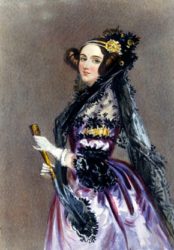Ada Lovelace (1815 – 1852) is a perfect example of a woman overcoming the restrictions of her time. Despite being born in nineteenth century England, Ada Lovelace progressed to be a brilliant, young and well-known mathematician – later even known as ‘the first programmer’ although this is an ongoing debate. Upon her mother’s instructions, Ada learnt about maths and science, instead of the subjects considered normal for an aristocratic girl of her age at the time. Her mother was said to have done this in order to make sure Ada did not become like her father, who was known to be an eccentric poet.
In 1835 Ada married Lord Lovelace – William King-Noel – when she was 22 years old and they had three children. However, Ada did not let this hinder her intellectual interest, and instead took to helping a man who is now known as ‘the Father of Computers’ named Charles Babbage who had begun a new idea – the Analytic Engine.
One example of Ada assisting Charles Babbage in his new idea, was when a paper was published about the machine in French, after Baggage had given a presentation about it in 1840, by Luigi Federico Menabrea. In turn, Ada Lovelace translated this paper, but not only that, she added her own annotations to it – including the possibility for it to be able to compose music as well as converting things such as pictures into digital form. This idea was so ahead of her time that it is hard to grasp how Ada could have possibly known this over a century before computers became an important part of the world we live in.

However, Ada Lovelace was not perfect, she had a major number of health problems which did eventually lead to her death at 35 years old, she had a nasty habit of gambling on horse races, and she did not pay much attention to her family. But her genius is indisputable. In her life she wrote about the computer revolution (the Analytic Engine was in essence the beginning of the world’s first computer but it was never built) which would happen in the next century as well as describing algorithms. It is hard to imagine what it would be like if Ada Lovelace had not been restricted by the time she lived in; she was responsible for writing the first software program ever, for a computer that was a prototype – and this occurred all in her head. Could you imagine the contributions she could have made if she were alive now?
Efforts have been made to remember Ada Lovelace such as Ada Lovelace Day, created in 2009, on the second Tuesday of October which was made to remember Ada Lovelace as well as to celebrate women in STEM (Science, Technology, Engineering and Mathematics). Also, the programming language Ada, was named after her. This is a woman truly worth remembering.
Sources:
https://www.britannica.com/biography/Ada-Lovelace
